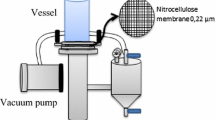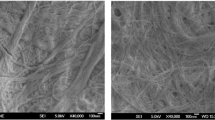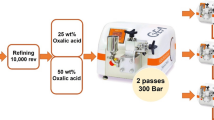Abstract
Cellulose nanofibers (CNF) have increasing relevance in different applications, for instance, in the paper industry as a sustainable strength additive. This application is especially beneficial for recycled paper, which reaches higher product quality despite its limitations. CNF change paper properties and also can affect the production process, especially the drainage stage, in which retention additives (RA) are commonly used to promote interaction of cellulose fibers. CNF probably interact with fibers and RA, affecting the drainage stage. However, these interactions vary depending on the type and flocculation mechanism of RA. This research is aimed at establishing possible synergies between CNF and RA to improve paper strength, avoiding negative effects on the drainage process. No further RA were used to retain CNF, taking advantage of the RA already used in the process. Polyvinylamine, chitosan, cationic starch, C-PAM, and C-PAM-B were selected as RA. CNF from eucalyptus kraft pulp and corn stalk organosolv pulp were tested. Strength properties of laboratory sheets were studied, and interactions were assessed by measuring Z-potential. Synergies between PVA, chitosan, C-PAM, and C-PAM-B with CNF were found. Drainage time decreased ranging between 30 and more than 40% using CNF. Strength depended on RA and formation quality. Among the studied options, CNF with C-PAM-B or chitosan resulted in the best formation and higher strengths with a significant drainage time reduction.







Similar content being viewed by others
References
Ahola S, Myllytie P, Österberg M, Teerinen T, Laine J (2008) Effect of polymer adsorption on celloluse nanofibril water binding capacity and aggregation. BioResources 3:1315–1328. doi:10.1007/s10570-007-9167-3
Alcalá M, González I, Boufi S, Vilaseca F, Mutjé P (2013) All-cellulose composites from unbleached hardwood kraft pulp reinforced with nanofibrillated cellulose. Cellulose 20:2909–2921. doi:10.1007/s10570-0130085-2
Balea A, Blanco A, Merayo N, Negro C (2016a) Effect of nanofibrillated cellulose to reduce linting on high filler-loaded recycled papers. Appita J 69:148–156
Balea A, Merayo N, Fuente E, Delgado-Aguilar M, Mutje P, Blanco A, Negro C (2016b) Valorization of corn stalk by the production of cellulose nanofibers to improve recycled paper properties. BioResources 11:3416–3431
Besbes I, Alila S, Boufi S (2011) Nanofibrillated cellulose from TEMPO-oxidized eucalyptus fibres: effect of the carboxyl content. Carbohyd Polym 84:975–983. doi:10.1016/j.carbpol.2010.12.052
Blanco A, Fuente E, Monte MC, Cortes N, Negro C (2009) Polymeric branched flocculant effect on the flocculation process of pulp suspensions in the papermaking industry. Ind Eng Chem Res 48:4826–4836
Brodin FW, Gregersen OW, Syverud K (2014) Cellulose nanofibrils: challenges and possibilities as a paper additive or coating material: a review. Nordic Pulp Paper Res J 29:156–166. doi:10.3183/NPPRJ-2014-29-01-p156-166
Delgado-Aguilar M, González I, Pèlach MA, de la Fuente E, Negro C, Mutjé P (2014) Improvement of deinked old newspaper/old magazine pulp suspensions by means of nanofibrillated cellulose addition. Cellulose 22:789–802. doi:10.1007/s10570-014-0473-2
Delgado-Aguilar M, Tarres Q, Puig J, Boufi S, Blanco A, Mutjé P (2015) Enzymatic refining and cellulose nanofiber addition in papermaking processes from recycled and deinked slurries. BioResources 10:5730–5743
Dinand E, Chanzy H, Vignon MR, Maureaux A, Vincent I (1999) U.S. Patent No. 5964983. U.S. Patent and Trademark Office, Washington, DC
Eriksen O, Syverud K, Gregersen O (2008) The use of microfibrillated cellulose produced from kraft pulp as strength enhancer in TMP paper. Nordic Pulp Paper Res J 23:299–304
González I, Boufi S, Pèlach MA, Alcalà M, Vilaseca F, Mutjé P (2012) Nanofibrillated cellulose as paper additive in eucalyptus pulps. BioResources 7:5167–5180
Hassan ML, Hassan EA, Oksman KN (2011) Effect of pretreatment of bagasse fibers on the properties of chitosan/microfibrillated cellulose nanocomposites. J Mater Sci 46:1732–1740
He M, Cho BU, Won JM (2016) Effect of precipitated calcium carbonate—Cellulose nanofibrils composite filler on paper properties. Carbohyd Polym 136:820–825
Hii C, Gregersen ØW, Chinga-Carrasco G, Eriksen Ø (2012) The effect of MFC on the pressability and paper properties of TMP and GCC based sheets. Nordic Pulp Paper Res J 27:388
ISO 5351 (2010) Pulps - Determination of limiting viscosity number in cupri-ethylene-diamine (CED). International Organization for Standardization, Geneva, Switzerland
Lavoine N, Desloges I, Bras J (2014) Microfibrillated cellulose coatings as new release systems foractive packaging. Carbohyd Polym 103:528–537. doi:10.1002/app.40106
Manninen M, Kajanto I, Happonen J, Paltakari J (2011) The effect of microbifrillated cellulose addition on drying shrinkage and dimensional stability of wood-free paper. Nordic Pulp Paper Res J 26:297–305. doi:10.3183/NPPRJ-2011-26-03-p297-305
Merayo N, Balea A, de la Fuente E, Blanco A, Negro C (2016) Interactions between cellulose nanofibers and retention systems in flocculation of recycled fibers. Cellulose. doi:10.1007/s10570-016-1138-0
Mörseburg K, Chinga-Carrasco G (2009) Assessing the combined benefits of clay and nanofibrillated cellulose in layered TMP-based sheets. Cellulose 16:795–806. doi:10.1007/s10570-009-9290-4
Osong SH, Norgren S, Engstrand P (2016) Processing of wood-based microfibrillated cellulose and nanofibrillated cellulose, and applications relating to papermaking: a review. Cellulose 23:93–123
Petroudy SRD, Syverud K, Chinga-Carrasco G, Ghasemain A, Resalati H (2014) Effects of bagasse microfibrillated cellulose and cationic polyacrylamide on key properties of bagasse paper. Carbohyd Polym 99:311–318. doi:10.1016/j.carbpol.2013.07.073
Salam A, Lucia LA, Jameel H (2013) A novel cellulose nanocrystals-based approach to improve the mechanical properties of recycled paper. ACS Sustain Chem Eng 1:1584–1592. doi:10.1021/sc400226m
Schlosser H (2008) Nano-disperse cellulose and nano-fibrillated cellulose - New products for paper and board manufacture and coating. Concepts Solut 9:41–44
Silva DD, Tapin-Lingua S, Lavalette A, Barbosa T, Gonzalez I, Siqueira G, Bras J, Dufresne A (2010) Impact of micro/nanofibrillated cellulose preparation on the reinforcement properties of paper and composites films. TAPPI International Conference on Nanotechnology for the Forest Products Industry, TAPPI, Espoo, Finland
Song HN, Ankerfors M, Hoc M, Lindstrom T (2010) Reduction of the linting and dusting propensity of newspaper using starch and microfibrillated cellulose. Nord Pulp Paper Res J 25:495
Syverud K, Stenius P (2009) Strength and barrier properties of MFC films. Cellulose 16:75–85. doi:10.1007/s10570-008-9244-2
Taipale T, Osterberg M, Nykanen A, Ruokolainen J, Laine J (2010) Effect of microfibrillated cellulose and fines on the drainage of kraft pulp suspension and paper strength. Cellulose 17:1005–1020
Acknowledgment
This work was supported by the Economy and Competitiveness Ministry of Spain with the projects with references CTQ2012-36868-C02-01 and CTQ2013-48090-C2-1-R.
Author information
Authors and Affiliations
Corresponding author
Rights and permissions
About this article
Cite this article
Merayo, N., Balea, A., de la Fuente, E. et al. Synergies between cellulose nanofibers and retention additives to improve recycled paper properties and the drainage process. Cellulose 24, 2987–3000 (2017). https://doi.org/10.1007/s10570-017-1302-1
Received:
Accepted:
Published:
Issue Date:
DOI: https://doi.org/10.1007/s10570-017-1302-1




